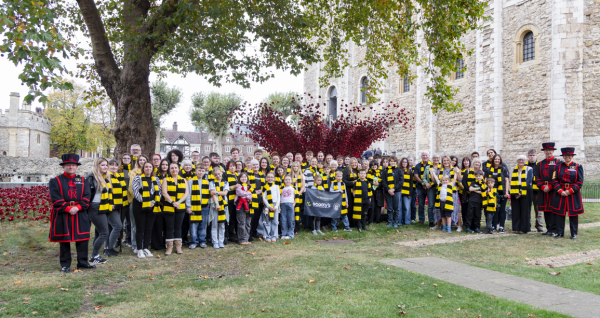Will the Tower of London Lose Its UNESCO World Heritage Status?
/https://tf-cmsv2-smithsonianmag-media.s3.amazonaws.com/filer_public/ce/f8/cef8907e-04e9-4f93-b22c-4ffb134e979d/tower_of_london_viewed_from_the_river_thames.jpg)
:focal(1974x1241:1975x1242)/https://tf-cmsv2-smithsonianmag-media.s3.amazonaws.com/filer_public/ce/f8/cef8907e-04e9-4f93-b22c-4ffb134e979d/tower_of_london_viewed_from_the_river_thames.jpg)
The Tower of London has loomed over the city since the 11th century.
Bob Collowan via Wikimedia Commons under CC BY-SA 3.0
The Tower of London has been a famous landmark and enduring symbol of royalty for nearly 1,000 years.
Built in the 11th century, the imposing structure became a UNESCO World Heritage site in 1988. But now, nearly four decades later, the Tower’s heritage status is in danger.
“In folklore, it’s said the Tower of London will fall if its flock of ravens fly away,” writes Artnet’s Richard Whiddington. “In reality, the former royal residence is at risk from the City of London Corporation’s (CLC) ambitious plans to redevelop the Square Mile, the historic financial district abutting the River Thames that includes St. Paul’s Cathedral and London Bridge.”
Much of the concern is focused on the CLC’s City Plan 2040, a development project involving the construction of 13 million square feet of office space. UNESCO is worried about “cumulative impacts” from these kinds of high-rise developments, as a spokesperson tells Ben Lynch of the BBC’s Local Democracy Reporting Service (LDRS).
UNESCO has asked the British government to submit a State of Conservation Report outlining efforts to protect the Tower by December 1. If the agency determines the government’s efforts are insufficient, it could strip the site of its World Heritage status.
The Tower of London was built by William the Conqueror beginning in the 1070s. Throughout its long history, the mighty fortress has served many roles: As Encyclopedia Britannica writes, it has been “a royal palace, a political prison, a place of execution, an arsenal, a royal mint, a menagerie and a public records office.”
The Tower of London in front of the Gherkin building, a skyscraper that opened in 2004 Public Domain via Wikimedia Commons/https://tf-cmsv2-smithsonianmag-media.s3.amazonaws.com/filer_public/bf/f3/bff33f7c-5506-4e42-8162-469729c2eba3/tower_london_swiss_re.jpg)
Today, the Tower is managed by the charity Historic Royal Palaces. Officials with the organization are also worried about the historic site’s future.
“As guardians of the Tower, we have significant concerns in respect of the current draft City Plan 2040 and consider the current approach and policies of the plan in respect of tall buildings and impact on the Tower of London to be unsound,” a spokesperson for Historic Royal Palaces tells the LDRS.
UNESCO’s concerns add additional pressure to an already tense relationship between the CLC and Historic England, the government body that protects the country’s historic and cultural landmarks, per Artnet.
Historic England and the International Council on Monuments and Sites (which advises UNESCO) have long been worried about new high-rise developments threatening the Tower’s “protected views and cultural value,” as Time Out’s Amy Houghton writes.
This isn’t the first time UNESCO has raised concerns about the Tower. According to Artnet, the agency reviewed similar issues in 2014, but it decided against placing the site on the List of World Heritage in Danger at that time.
If the Tower were to lose its heritage status, it would join the only other three sites to be dropped from UNESCO’s list: Liverpool’s waterfront, Germany’s Dresden Elbe Valley and Jordan’s Arabian Oryx Sanctuary.
link






